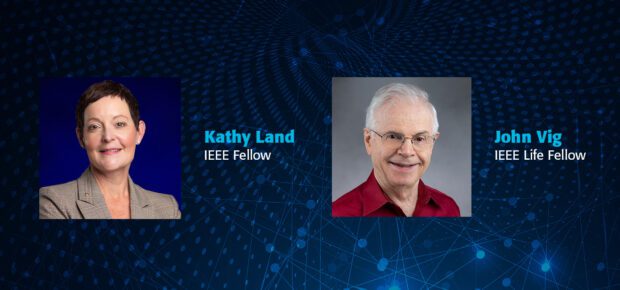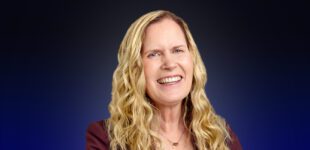July 13, 2023
IEEE Fellow Kathy Land and IEEE Life Fellow John Vig have storied histories within IEEE, with both serving terms as President — Land in 2021 and Vig in 2009. Land finished her undergraduate degree in education, and went on to become a computer scientist. Vig is a physicist by training, and was involved in the push to open IEEE’s membership to people with degrees in other fields.
“Whenever I could, I would advocate that we take steps to be known as an organization of technologists, not just engineers,” Vig said in an interview with the IEEE History Center. “If you work on anything that is in IEEE’s fields of interest, you are welcome in IEEE. You don’t have to be an engineer to become a member of IEEE. If you work in IEEE’s fields of interest, the IEEE should be your professional home.”
Land’s Trajectory
She’s a computer scientist who has developed applications for cell phones, massive multiplayer online games and complex software systems. Today, she’s a program manager in the U.S. Missile Defense Agency.
But her path to those accomplishments began at the University of Georgia, where Land earned a bachelor’s of science degree in science education. She’d followed in the footsteps of her mother and her aunts at a time when women were just beginning to break patterns that saw their professional aspirations funneled into careers like nursing and teaching.
At the time, she wasn’t sure what she wanted to do, but she avoided the computer science department, which, incidentally, was established the year she graduated.
“All I remember is that I avoided the computer engineering building on campus where the lights were on all night and classroom success was based upon an accurately stacked set of key punch cards – not something I found attractive at the time,” Land said.
In their own words: Explore the diverse professional trajectories and personal stories of IEEE members.
She landed her first job at her alma mater, working on an IBM mainframe computer responsible for the layout of complex genetic tables to support grant proposals. She parlayed that into a job at the Pacific Missile Test Center, first as a clerk, then as a computer systems specialist.
She called that era – the 1980s and early 1990s – the “wild west of computer engineering”. The technical landscape was changing daily, and there was a shortage of competent software developers. Land often faced one other challenge: because the industry was so new, the work environment for programmers and software developers wasn’t standardized.
It was around this time that she discovered IEEE and the IEEE Computer Society.
“IEEE provided me with accepted guidance to support team training for competencies like requirements management, configuration management and quality assurance,” Land said. “This early linkage with IEEE, and its experts, taught me to look to authoritative sources to help me be as effective as possible and to share the information with others.”
It was the beginning of a long relationship with IEEE, an organization she eventually led.
“My experience as an IEEE Computer Society volunteer motivated me to devote my time and energy to IEEE, and I know that every volunteer I meet values being part of our technical professional community. The strength of IEEE is built from the bottom up. Those who attend society and local meetings, share their knowledge and experience and help with the heavy lifting of coordinating and communicating IEEE activities are the ones who make IEEE strong.”
Vig’s Career
“I did not have an ‘engineering’ career,” Vig said. “Never in my life did I take an ‘engineering’ class.”
Vig’s path to IEEE started after he completed his Ph.D in physics at Rutgers University in New Jersey. A stint in the U.S. Army led to a civilian position in an army research facility. Vig thought it was a temporary position while he looked for a job in his primary research area – low temperature physics.
He stayed for 36 years, researching resonators and oscillators for clocks, communications systems, GPS systems and low-noise oscillators for radar systems. He joined IEEE after a friend in his lab asked him to serve on the technical program committee of the IEEE Ultrasonics Symposium.
If his service to IEEE were a resume, it would be a long one. Here are some of the highlights: He was the founding president of the IEEE Sensors Council, and the president of the IEEE Ultrasonics, Ferroelectrics and Frequency Control Society. He served as a division director, as vice-president of technical activities, and in 2009, as IEEE President and CEO.
In his professional life, he stressed that he has worked with professionals with a wide range of expertise, including chemists, electrical engineers and material scientists.
Vig also noted that IEEE keeps a pulse on the demographic of its membership and the variety of technical disciplines its members represent.
“According to a 2021 IEEE member survey, about one-third of IEEE higher grade members (i.e. other than students) do not have an electrical engineering (EE) degree,” Vig noted. “Additionally, more than half of female higher grade members (57 percent) do not hold an EE degree. This speaks to the vast experience of the technologists who are the core of IEEE.”
Learn more: Inspiration, passion, creativity, collaboration. No matter where you are on your career journey, find out why IEEE can be your professional home.





 AI Through Our Ages
AI Through Our Ages Liquid Infrastructure: Our Planet's Most Precious Resource
Liquid Infrastructure: Our Planet's Most Precious Resource The Impact of Technology in 2025
The Impact of Technology in 2025 Quantum and AI: Safeguards or Threats to Cybersecurity?
Quantum and AI: Safeguards or Threats to Cybersecurity? Why AI Can't Live Without Us
Why AI Can't Live Without Us Bits, Bytes, Buildings and Bridges: Digital-Driven Infrastructure
Bits, Bytes, Buildings and Bridges: Digital-Driven Infrastructure Impact of Technology in 2024
Impact of Technology in 2024 Emerging AI Cybersecurity Challenges and Solutions
Emerging AI Cybersecurity Challenges and Solutions The Skies are Unlimited
The Skies are Unlimited Smart Cities 2030: How Tech is Reshaping Urbanscapes
Smart Cities 2030: How Tech is Reshaping Urbanscapes Impact of Technology 2023
Impact of Technology 2023 Cybersecurity for Life-Changing Innovations
Cybersecurity for Life-Changing Innovations Smarter Wearables Healthier Life
Smarter Wearables Healthier Life Infrastructure In Motion
Infrastructure In Motion The Impact of Tech in 2022 and Beyond
The Impact of Tech in 2022 and Beyond Cybersecurity, Technology and Protecting Our World
Cybersecurity, Technology and Protecting Our World How Technology Helps us Understand Our Health and Wellness
How Technology Helps us Understand Our Health and Wellness The Resilience of Humanity
The Resilience of Humanity Harnessing and Sustaining our Natural Resources
Harnessing and Sustaining our Natural Resources Creating Healthy Spaces Through Technology
Creating Healthy Spaces Through Technology Exceptional Infrastructure Challenges, Technology and Humanity
Exceptional Infrastructure Challenges, Technology and Humanity The Global Impact of IEEE's 802 Standards
The Global Impact of IEEE's 802 Standards Scenes of our Cyber Lives: The Security Threats and Technology Solutions Protecting Us
Scenes of our Cyber Lives: The Security Threats and Technology Solutions Protecting Us How Millennial Parents are Embracing Health and Wellness Technologies for Their Generation Alpha Kids
How Millennial Parents are Embracing Health and Wellness Technologies for Their Generation Alpha Kids Space Exploration, Technology and Our Lives
Space Exploration, Technology and Our Lives Global Innovation and the Environment
Global Innovation and the Environment How Technology, Privacy and Security are Changing Each Other (And Us)
How Technology, Privacy and Security are Changing Each Other (And Us) Find us in booth 31506, LVCC South Hall 3 and experience the Technology Moon Walk
Find us in booth 31506, LVCC South Hall 3 and experience the Technology Moon Walk Virtual and Mixed Reality
Virtual and Mixed Reality How Robots are Improving our Health
How Robots are Improving our Health IEEE Experts and the Robots They are Teaching
IEEE Experts and the Robots They are Teaching See how millennial parents around the world see AI impacting the lives of their tech-infused offspring
See how millennial parents around the world see AI impacting the lives of their tech-infused offspring Take the journey from farm to table and learn how IoT will help us reach the rising demand for food production
Take the journey from farm to table and learn how IoT will help us reach the rising demand for food production Watch technical experts discuss the latest cyber threats
Watch technical experts discuss the latest cyber threats Explore how researchers, teachers, explorers, healthcare and medical professionals use immersive technologies
Explore how researchers, teachers, explorers, healthcare and medical professionals use immersive technologies Follow the timeline to see how Generation AI will be impacted by technology
Follow the timeline to see how Generation AI will be impacted by technology Learn how your IoT data can be used by experiencing a day in a connected life
Learn how your IoT data can be used by experiencing a day in a connected life Listen to technical experts discuss the biggest security threats today
Listen to technical experts discuss the biggest security threats today See how tech has influenced and evolved with the Games
See how tech has influenced and evolved with the Games Enter our virtual home to explore the IoT (Internet of Things) technologies
Enter our virtual home to explore the IoT (Internet of Things) technologies Explore an interactive map showcasing exciting innovations in robotics
Explore an interactive map showcasing exciting innovations in robotics Interactively explore A.I. in recent Hollywood movies
Interactively explore A.I. in recent Hollywood movies Get immersed in technologies that will improve patients' lives
Get immersed in technologies that will improve patients' lives